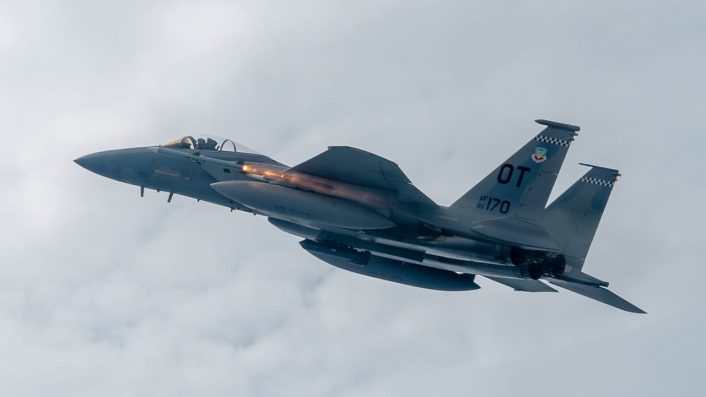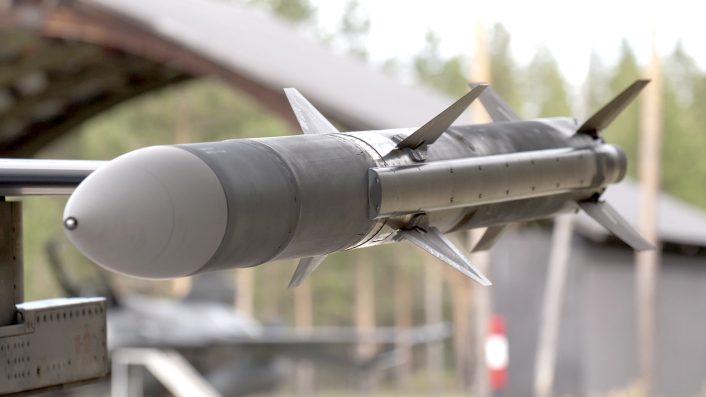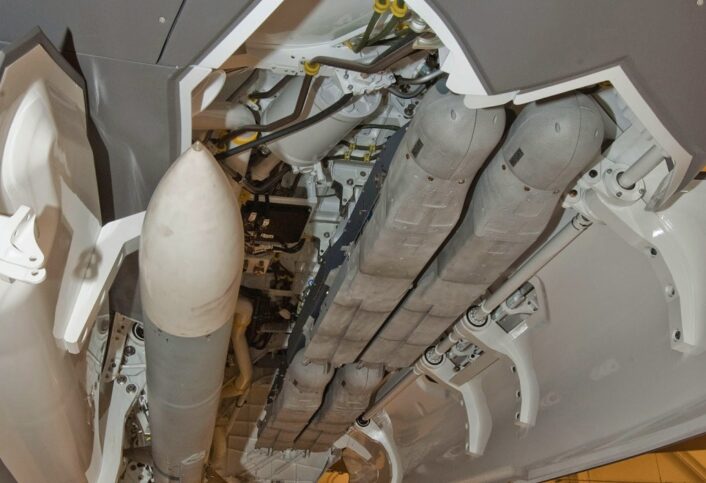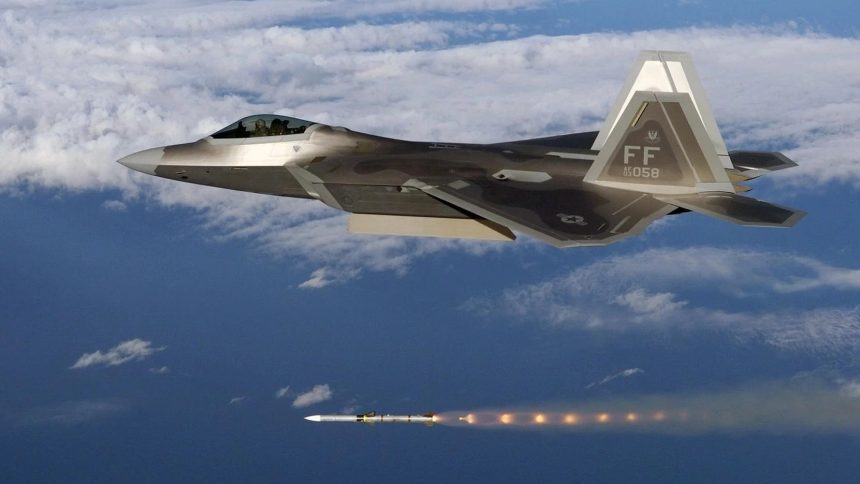Recently disclosed tests with the F-22 set a new record for the AIM-120 AMRAAM in 2024, part of the form, fit, function refresh (F3R) development effort.
The AIM-120 Advanced Medium-Range Air-to-Air Missile (AMRAAM), the backbone of Western beyond-visual-range air combat for more than three decades, has achieved its longest known shot to date. RTX’s Raytheon confirmed on Sept. 16, 2025, after receiving approval from the U.S. Air Force, that an F-22 Raptor successfully executed the record-breaking test in late 2024.
The test, conducted over the Eglin Air Force Base range in Florida, demonstrated what Raytheon described as “extended time of flight” capability for the AMRAAM, effectively pushing the missile’s reach further than ever before. While the Air Force has not disclosed the exact distance covered, and the AIM-120’s range is classified, officials emphasized that the test represents the longest known AMRAAM shot by a fifth-generation fighter.
The previous longest shot was achieved in 2021, with the launch platform being the F-15C Eagle. On that occasion, the missile struck a BQM-167 subscale drone during WSEP (Weapons Systems Evaluation Program) East at Tyndall AFB, Florida.
Software-Driven Performance Gains
According to the manufacturer, the record was achieved following the form, fit, function refresh (F3R) development effort to enhance AMRAAM’s performance. What makes the achievement particularly noteworthy is that the enhanced range was described mainly as the result of software and systems improvements.

According to Air & Space Forces Magazine, the AIM-120D used in the test incorporated F3R updates which included modernized electronics, a more efficient battery, and optimized software with flight profiles that exploit the high speed and altitude of platforms such as the F-22 and F-35.
Jon Norman, Raytheon’s vice president of requirements and capabilities, explained that the missile’s aerodynamics and propulsion always had the potential for longer reach, but only recent software refinements unlocked that capability. “We were able to fly it much longer,” Norman said. “It’s flying higher and longer. We can fly at a much faster speed at release, which just improves the performance of the missile.”
This “fly-out optimization” enables AMRAAM to retain more kinetic energy at long ranges, giving pilots the ability to engage targets farther away and with higher probability of success. Importantly, because the changes are software-driven, operators require no additional training, allowing to quickly field the new capability.
Building on a History of Record Shots
The latest milestone comes just four years after another record-setting AMRAAM test. As mentioned earlier, in 2021, during a Weapons System Evaluation Program (WSEP) event at Tyndall AFB, an F-15C Eagle achieved the then-longest known air-to-air missile shot, striking a BQM-167 drone target.

Now, the Raptor has claimed the new record, showing that fifth-generation platforms can take full advantage of AMRAAM’s evolving capabilities. The continuity of record-breaking shots across platforms also illustrates how the missile has remained adaptable across generations of fighters, from legacy aircraft to stealth designs.
As noted on other occasions, the AIM-120 was first installed on 4th generation fighters, such the F-15, F-16 and F/A-18, in the A and B variants. Then, with the advent of the F-22, the missile evolved in the C variant, which also included smaller control surfaces so it would fit inside the Raptor’s weapons bays.
A Global Missile for a Global Threat Environment
Since entering service in the early 1990s, AMRAAM has become the benchmark for medium- and long-range air-to-air engagements. Integrated on 14 platforms across 43 countries and with more than 6,000 live firings to its name, the missile has proven itself in combat multiple times.
Its versatility extends beyond air-to-air engagements, as it can also be deployed from the ground via the NASAMS air defense system. Raytheon executives often describe AMRAAM as the “capacity weapon” of future U.S. and allied forces – a reliable, affordable, and scalable option for high-volume use – as demonstrated by recent large procurement contracts.

In contrast, the Air Force is also developing the Lockheed Martin AIM-260 Joint Advanced Tactical Missile (JATM), intended as a higher-performance, longer-range “exquisite” solution. While initially intended as a replacement for the older type, the AIM-260 is now expected to provide together with the AIM-120D3 a high-low mix of air dominance weapons.
Norman highlighted this complementary role during press briefings in 2024: “AMRAAM is approaching the threshold capability that the Air Force would like to have with JATM. Look at AMRAAM as your capacity weapon. … It’s the affordable weapon.”
Competitive Edge Against Advanced Threats
Peer adversary air forces around the world are fielding increasingly capable long-range missiles. China’s PL-15, for instance, is widely reported to have a range of up to 200-300 kilometers (108-162 nautical miles), while the export variant, PL-15E, reaches about 145 kilometers (78 nautical miles). Russia’s R-37M is also credited with extreme ranges exceeding 300 kilometers (162 nautical miles).
By comparison, the AIM-120D is believed to have a range in excess of 160 km (86 NM), though officials remain tight-lipped about the exact distances demonstrated in the latest test. Raytheon insists the missile’s refinements bring it back into parity with pacing threats worldwide, and potentially beyond.
“We didn’t change propulsion,” Norman explained of the new D3 variant. “We just changed the way it flies for long-range shots, so it has more kinetic energy when it hits the target at that range.”
In addition to range improvements, the latest updates also include enhanced resistance to advanced electronic warfare techniques, such as digital radio frequency modulation (DRFM) jamming. This ensures the missile remains effective against modern countermeasures which are getting more sophisticated day-by-day.

Production and Global Demand
The AMRAAM program has seen record levels of production and investment in recent years. In July 2025, Raytheon was awarded a $3.5 billion contract for Production Lots 39 and 40 – the largest AMRAAM award to date – covering U.S. services and multiple Foreign Military Sales customers. This contract surpassed the previous largest one awarded in September 2024 and worth $1.19 billion.
Demand for AMRAAM has surged from historical averages of 450–650 missiles annually to over 1,200 units in recent lots. The company is also exploring options for international co-production, with Japan emerging as a potential partner.
For the U.S. Air Force, sustainment and modernization efforts are equally important. A recent $760 million contract will fund “mitigation of obsolescence” in production and sustainment, ensuring AMRAAM remains viable for years to come, further demonstrating that the service will continue to rely on this weapon for the years to come.
Looking Ahead
The record-setting shot by the F-22 confirms that the AIM-120 AMRAAM remains a central element of U.S. and allied air dominance strategies. While newer systems like the AIM-260 JATM are being developed to counter advanced threats, AMRAAM’s software-driven evolution, broad integration across platforms, and proven combat track record guarantee its continued frontline role.
As Sam Deneke, president of Air & Space Defense Systems at Raytheon, put it: “AMRAAM is already known as the gold standard for the air dominance arena, and these tests prove it will continue to play a critical role for the U.S. and its allies for decades to come.”









